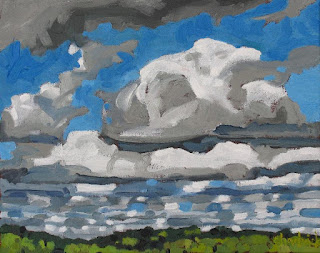 |
| #0135 "Tiger on the Prowl" |
Energy is neither created or destroyed… but energy is often converted from one form into another. In "Adding Friction to the Wind Balance" I described how friction with the earth in the planetary boundary layer (PBL) would always turn the gradient wind (see "Another Look at the Wind") toward lower pressure. Your Coriolis arm would turn toward lower pressure with increased friction and if you kept your thumb pointed in the direction of the pressure gradient force, the angle between your thumb and fingers would get smaller with increased friction.
 |
| Summary Explanation of the Gradient Wind, Friction and your Coriolis Arm |
 |
| Vagn Walfrid Ekman (1874 – March 1954) |
1893–1896 which was tasked to reach the geographical North Pole by harnessing the natural east–west current of the Arctic Ocean. During the expedition, Nansen observed that icebergs tended to drift not in the direction of the prevailing wind but at an angle of 20 to 40 degrees to the right. Hmmm. Bjerknes invited Ekman, still a student, to investigate the problem. Vilhelm Bjerknes you might recall, could be called the father of modern meteorology as he formulated the primitive equations that we use in meteorology and numerical weather prediction. Vilhelm and his son Jacob figure prominently in "Weather Dances" where I discus their Norwegian cyclone model and the military terms used therein since they did much of the work with the backdrop of World War One.
The science of meteorology and oceanography were incredibly intertwined more than a hundred years ago.
Now back to the energy conversions to drive this point home. The wind energy of the free atmosphere is transformed by friction with the earth’s surface into angular momentum of the earths rotation (more on this in another blog). In addition, as the wind approaches the rough surface, your wind balanced Coriolis arm turns toward lower pressure and the wind speed decreases with that energy shoving the earth along. This is the Ekman spiral in the atmosphere as pictured above using my waving hand and arm.
 |
| Oceanographic Ekman Spiral where 1 is the friction PBL wind, 2 is the force from above, 3 is the direction of the resultant current (vector addition) and 4 is the Coriolis force |
The energy of the atmospheric wind can drive the energy of the oceanographic Ekman spiral which in turn (so to speak) drives the coastal upwelling which encourages the fishery and feeds nations. Nothing is lost and all is sustainable IF this energy and these resources are managed wisely.
 |
| Ekman driven Upwelling |
 |
| Everything is connected... |
Oceanography and meteorology are sciences of fluids on a spinning globe. Both are vitally important to the welfare of the planet and the creatures that share this garden of Eden. I have been a life long member and supporter of the Canadian Meteorological and Oceanographic Society. We are all in this together… air, water and sometimes even rock are fluids. Maybe we should add volcanology to the society of fluid sciences as well!
Warmest regards and keep your paddle in the water,
Phil the Forecaster Chadwick











